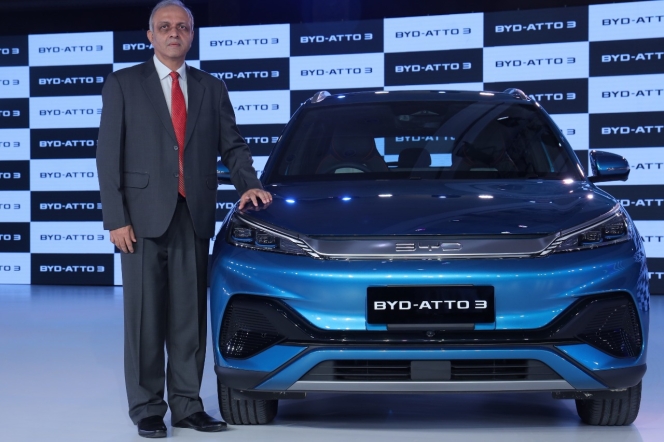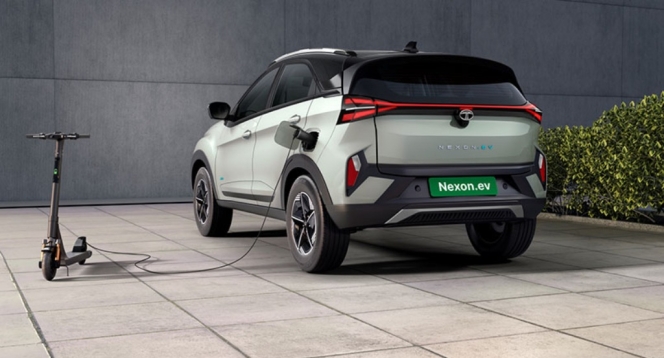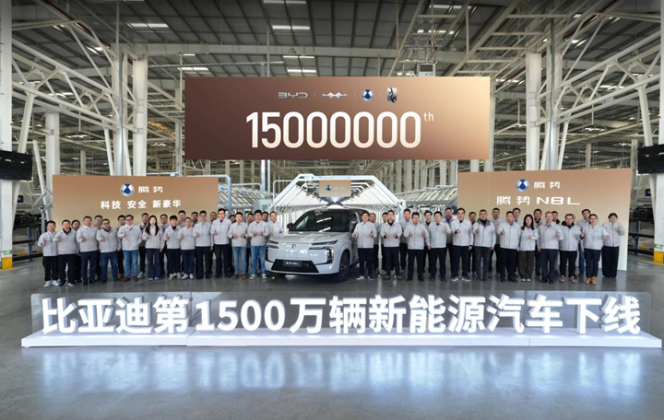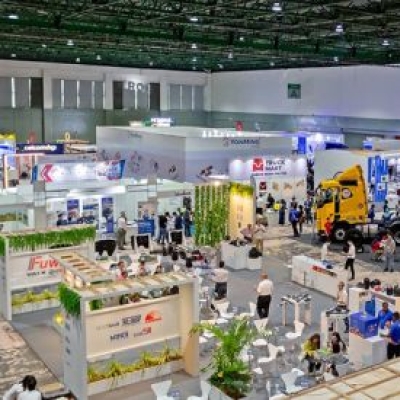BYD launches premium electric SUV, BYD-ATTO 3
- By MT News
- October 11, 2022

BYD, an energy vehicle manufacturer, launched the premium electric SUV, BYD-ATTO 3, today. BYD claims that this is India’s first sporty born e-SUV. This also marks BYD’s official entry into the Indian passenger vehicle market with its brand mission of “technological innovations for a better life”.
Sharing his thoughts on the launch, Sanjay Gopalakrishnan, Senior Vice President – Electric Passenger Vehicles, BYD India, said, “We are happy to announce the launch of our much-acclaimed electric SUV in India. With proven and innovative technology, we are on track towards building a stronger ecosystem that facilitates EV adoption in our country. The launch of BYD-ATTO 3 is a step towards this mission. We will constantly contribute to building a greener future.”
Adding to this, Ketsu Zhang, Executive Director of BYD India, said, “BYD has two plants in India, covering more than 140,000 sqm with 3,000 employees and a cumulative investment of over $200 million in the country. We are fully committed to India’s goal of achieving net-zero emissions by 2070, and will promote sustainability and zero emissions by introducing pure electric vehicles and the latest technologies. We intend to sell 15,000 units of BYD-ATTO 3 in India over the next year and plan to set up a local manufacturing facility in due course.”
BYD-ATTO 3 Features
Faster charging and higher battery capacity
According to BYD, BYD-ATTO 3 is equipped with the ultra-safe blade battery and the born EV platform (e-Platform 3.0). It features fast charging, from 0 percent to 80 percent within 50 minutes and a range of 521 kilometres (according to ARAI tests), with a higher battery capacity of 60.48 kWh and a 0-100 km/h acceleration time of 7.3 seconds.
Blade battery
Powered by the blade battery, BYD-ATTO 3 passes the nail penetration test (one of the industry’s most rigorous tests for batteries), as per the energy vehicle manufacturer. The battery also emerged unscathed and fully operational, without exhibiting leakage, deformation or smoke, after a 46-tonne truck drove over it.
e-Platform 3.0
The energy vehicle manufacturer further states that BYD-ATTO 3 is the first model in India built on the e-Platform 3.0. The platform features the world’s first eight in one electric powertrain (with drive motor, motor controller, reducer, onboard charger, DC converter, high-voltage distribution box, vehicle controller and Battery Management System (BMS) integrated), claims the company. This results in a 20 percent overall size reduction, 15 percent weight reduction and allowing the overall efficiency to exceed 89 percent.
Leading configurations
What’s more, as per BYD, with a sporty and powerful exterior and rhythmic interior, this premium electric SUV comes with the following –
A robust steel body structure
L2 Advanced Driving Assistance System (ADAS) BYD Dipilot
Seven airbags
A safety-oriented chassis design
A panoramic sunroof
A 12.8-inch adaptive rotating suspension electronic pad
A 360-degree holographic transparent imaging system
NFC card key
A Vehicle to Load (VTOL) mobile power station
Apart from these, BYD-ATTO 3 includes other leading configurations as well. The panoramic sunroof and imaging system are the largest among cars in the segment. All these make the car competitive in the market, states BYD.
The mobile power station
The mobile power station in BYD-ATTO 3 allows the vehicle to transform into a super-mobile power bank. BYD claims that this power station supports power of up to 3.3 kw, satisfying most needs of high-power electrical appliances.
Dragon Face 3.0 design language
Plus, the energy vehicle manufacturer states that its latest car features sharp lines and a strong, sporty posture, adding to the aesthetics of the Dragon Face 3.0 design language led by Wolfgang Egger, BYD’s design director. Its advanced cabin is styled in the spirit of sports and competition. Inspired by the interior design concept of gym and music, BYD-ATTO 3 exhibits passion, energy and power, claims BYD.
Panoramic sunroof
The panoramic sunroof in the car measures 1,261 mm long and 849 mm wide, with an electric slide and anti-pinch features, according to BYD.
BYD DiPilot L2 driving assist system
Additionally, BYD-ATTO 3 provides intelligent driving systems and multi-sensor layouts with the BYD DiPilot L2 driving assist system.
Other features
As per BYD, the car also has other features, such as mobile phone wireless charging, one-touch electric control tailgate, NFC card key, an eight-speaker audio system, electric seat adjustment, voice control, LED headlamps, LED rear lights, multi-color gradient ambient lighting that responds to music rhythm, PM 2.5 air filter, CN95 air filter, etc.
Chartered Speed Deploys Electric Buses For DCM Shriram Staff Transport
- By MT Bureau
- December 24, 2025

Chartered Speed has deployed 11 electric buses for staff transportation for DCM Shriram at Jhagadia GIDC, Bharuch. The service was inaugurated by Sanyam Gandhi, Whole-time Director at Chartered Speed and Aditya Shriram, Deputy Managing Director at DCM Shriram.
The deployment is part of an effort to shift employee mobility towards electrification. Chartered Speed operates a fleet of over 2,000 buses across six states, serving 350,000 passengers daily.
The electric buses are equipped with several technologies for fleet management and passenger safety. It comes with real-time GPS tracking and onboard Driver Monitoring Systems (DMS). CCTV cameras, fire protection systems and first-aid kits are installed in every vehicle.
The company currently provides school and staff transportation services to various clients, including GHCL Limited and Apple Global School.
Sanyam Gandhi, Whole-time Director, Chartered Speed, said, “With the recent deployment of electric buses, we are strengthening our commitment to reducing the carbon footprint of our operations and supporting the transition to greener transportation solutions. Our vision is of building a large, clean energy-powered fleet that aligns with global trends towards electrification in public transport. We remain focused on integrating technology in our services not only enhances operational efficiency but also fosters a culture of safety that we believe is essential for the future of transportation.”
- Tata Motors
- TATA.ev
- Nexon.ev
- Tiago.ev
- Curvv.ev
- Harrier.ev
- XPRES-T EV
- Shailesh Chandra
- Sierra.ev
- Punch.ev
- Avinya
- Agratas
Tata Motors Surpasses 250,000 EV Sales In India
- By MT Bureau
- December 23, 2025

Tata Motors, one of the leading passenger vehicle manufacturers in the country, has attained a new milestone in the Indian electric vehicle (EV) market, with cumulative sales of its TATA.ev range exceeding 250,000 units.
Since the launch of the Nexon.ev in 2020, the company has secured a 66 percent market share of all electric passenger vehicles sold in India to date. The Nexon.ev has become the first electric model in the country to surpass 100,000 cumulative sales.
At present, the company’s green vehicle offering includes the Tiago.ev, Punch.ev, Nexon.ev, Curvv.ev and Harrier.ev for personal use, alongside the XPRES-T EV for fleet operations.
To support its EV customers, Tata Motors has established an ecosystem, which includes access to over 200,000 charging points, including home, community and public chargers. A digital platform providing coverage for over 20,000 public chargers. Around 100 mega charging hubs operational across key corridors, offering speeds of more than 120kW. Approximately 1,500 dedicated EV service bays nationwide, staffed by over 5,000 technicians.
The automaker stated that every TATA.ev vehicle is manufactured with more than 50 percent local content. In collaboration with other Tata Group companies, the firm has localised the production of battery packs and battery management systems. The supply chain also includes domestic production of power electronics, wiring harnesses and thermal management systems.
Going forward, Tata Motors has outlined a robust growth strategy through to 2030:
- Upcoming Launches: The Sierra.ev and a new Punch.ev are scheduled for release in CY26, followed by the Avinya luxury range at the end of 2026.
- Portfolio Growth: Five new nameplates are planned by FY2030.
- Infrastructure Targets: The company aims for 400,000 charge points by CY2027 and 1 million by 2030.
- Battery Sourcing: Future models will use battery cells produced at the Agratas gigafactory in Sanand.
Shailesh Chandra, MD & CEO, Tata Motors Passenger Vehicles, said, “Crossing 250,000 EV sales reflects how electric mobility is fast becoming part of everyday Indian life. Our customers are driving more, travelling farther, and increasingly trusting EVs as their only cars. Our EV journey which began in 2018, was never about leading alone but about building the ecosystem to enable India’s transition to clean mobility. This progress is the outcome of the government’s forward-thinking policies, the steadfast support of our supplier partners and charging infrastructure providers and above all, the trust and enthusiasm of TATA.ev customers. As EV adoption accelerates, our commitment remains clear: to mainstream electric mobility by making it accessible across segments, strengthening the ecosystem, and investing in India-first technology and localization. This is how we will continue to lead India’s growing EV market.”
The company also intends to focus on the circular economy by reusing batteries for energy storage and providing battery health checks for second-hand owners.
Forsee Power To Supply ZEN LFP Battery Systems To Mexico's MegaFlux
- By MT Bureau
- December 22, 2025

French-headquartered battery systems manufacturer Forsee Power has announced that MegaFlux, a Mexico-based powertrain integrator, has selected its ZEN LFP battery system for its heavy vehicle electric powertrains.
MegaFlux develops electric powertrains for trucks and buses, including retrofit solutions that convert diesel vehicles to electric. The company also provides charging infrastructure and energy management services.
The ZEN LFP product line uses lithium-ion LFP chemistry and is designed for buses, trucks and off-highway vehicles. The batteries are available in 36 kWh and 55 kWh formats, allowing for various voltage and energy combinations. The LFP battery has an energy density of 240 Wh/L. Being a modular system, upto to two modules can be stacked to optimise vehicle space. The battery has 6,000 charging lifecycle and is ISO 26262 ASIL-C and industry standards including R100-3 and R10.6 certified.
The use of LFP (Lithium Iron Phosphate) chemistry is intended to provide a lower Total Cost of Ownership (TCO) for operators due to its thermal stability and cycle life, factors that are relevant to the operating conditions in markets such as Mexico.
MegaFlux will integrate the ZEN LFP batteries into powertrains sold to original equipment manufacturers (OEMs) and into its vehicle conversion projects.
BYD Rolls Out 15 Millionth New Energy Vehicle As Global EV Sales Rise
- By MT Bureau
- December 19, 2025

Chinese automotive major BYD has celebrated the production of its 15 millionth new energy vehicle (NEV) at its Jinan Factory. The milestone vehicle is a Denza N8L, which also represents the 15,000th unit of this six-seat SUV model.
The company reported sales of 4.182 million units from January to November 2025, a YoY growth of 11.3 percent. Global markets contributed to this performance, with overseas sales reaching 917,000 units, surpassing the total volume recorded in 2024. BYD now operates in more than 119 countries and regions.
Technological innovation continues to drive the company's operations. In the first three quarters of 2025, R&D expenditure rose to CNY 43.75 billion, a 31 percent increase compared to the previous year. Total cumulative investment in research and development has now exceeded CNY 220 billion.
The Denza brand has entered markets in Singapore, Thailand and Malaysia. During the first half of the year, the Denza D9 became the top-selling luxury MPV in Indonesia, Thailand and Malaysia.
The brand has extended its presence into Europe and Latin America. This expansion is part of a strategy to increase the electrification of the global luxury automotive sector. Denza recently showcased the D9 at the São Paulo International Motor Show to support its growth in the region.






Comments (0)
ADD COMMENT